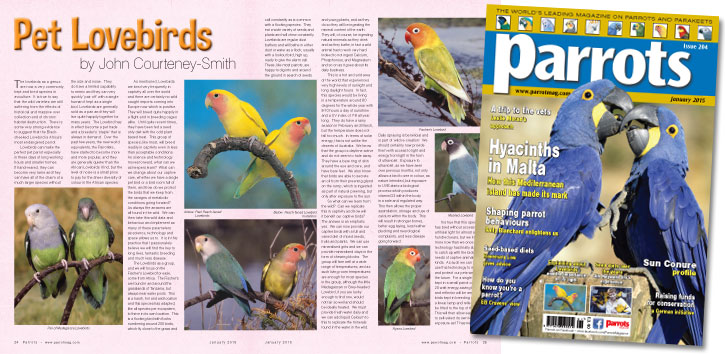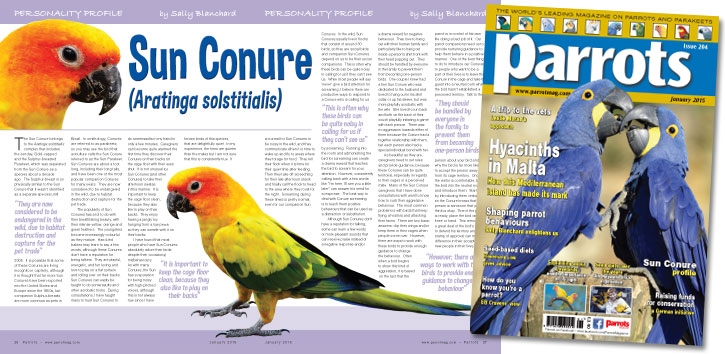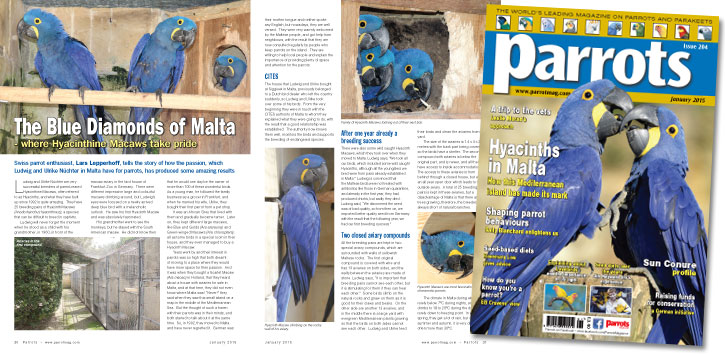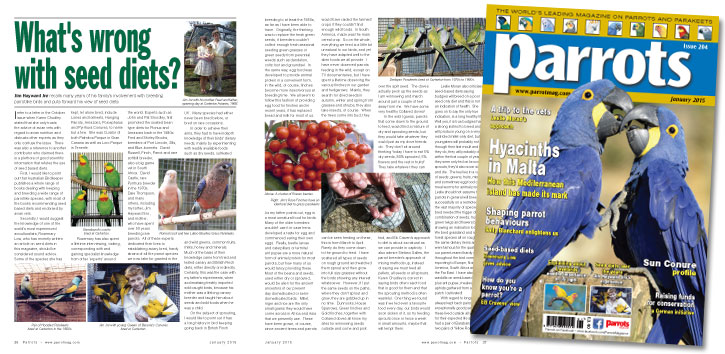
By John Courteney-Smith
The lovebirds as a genus are now a very commonly kept and bred species in aviculture. It is true to say that the wild varieties are still suffering from the effects of historical and massive over collection and of chronic habitat destruction. There is some very strong evidence to suggest that the Black-cheeked Lovebird is Africa’s most endangered parrot.
Lovebirds can make the perfect pet parrot especially in these days of long working hours and smaller homes. If hand-reared, they can become very tame and they can have all of the charm of a much larger species without the size and noise. They do have a limited capability to mimic and they can very quickly ‘pair off’ with a single human if kept as a single bird. Lovebirds are generally sold as a pair and they will live quite happily together for many years. The Lovebird has in effect become a pet trade and a breeder’s ‘staple’ that is always in demand. Over the past few years, the new world equivalents, the Parrotlets, have started to become more and more popular, and they are generally quieter than the African Lovebirds I find, but the level of noise is a small price to pay for the sheer diversity of colour in the African species.
Buy Now!

Sun Conure (Aratinga solstitialis)
The Sun Conure belongs to the Aratinga solstitialis complex that includes the Jenday, Gold-capped and the Sulphur-breasted Parakeet, which was separated from the Sun Conure as a species about a decade ago. The Sulphur-breast is so physically similar to the Sun Conure that it wasn’t identified as a separate species until 2005. It is possible that some of these Conures are living incognito in captivity, although it is thought that far more Sun Conures have been exported into the United States and Europe since the 1850s, but companion Sulphur-breasts are more common as pets in Brazil. In ornithology, Conures are referred to as parakeets, so you may see the bird that aviculture calls the Sun Conure referred to as the Sun Parakeet. Sun Conures are about a foot long, including their long tails, and have been one of the most popular companion Conures for many years. They are now considered to be endangered in the wild, due to habitat destruction and capture for the pet trade.
Buy Now!

- where Hyacinthine Macaws take pride
Swiss parrot enthusiast, Lars Lepperhoff, tells the story of how the passion, which Ludwig and Ulrike Nüchter in Malta have for parrots, has produced some amazing results.
Ludwig and Ulrike Nüchter are very successful breeders of parent-reared Hyacinthine Macaws, often referred to as Hyacinths, and what they have built up since 1992 is quite amazing. They have 25 breeding pairs of Hyacinth Macaws (Anodorhynchus hyacinthinus), a species that can be difficult to breed in captivity.
Ludwig will never forget the moment when he stood as a child with his grandmother, in 1960, in front of the macaw aviary in the bird house of Frankfurt Zoo in Germany. There were different impressive large and colourful macaws climbing around, but Ludwig's eyes were focused on a newly arrived deep blue bird with a melancholic outlook. He saw his first Hyacinth Macaw and was absolutely fascinated.
His grandmother went to see the monkeys, but he stayed with the South American macaw. He did not know then that he would one day be the owner of more than 100 of these wonderful birds. As a young man, he followed the family business as a grocer in Frankfurt, and when he married his wife, Ulrike, they bought their first parrot from a pet shop.
Buy Now!

By Jim Hayward Jnr
Jim Hayward Jnr recalls many years of his family's involvement with breeding parrotlike birds and puts forward his view of seed diets.
I refer to a letter in the October issue when Karen Chudley stated that she only trusts the advice of avian vets with regard to avian nutrition and distrusts other experts as they only confuse the issue. There was also a reference to another contributor who claimed there is a plethora of good scientific information that refutes the use of seed based diets.
First, I would like to point out that Australian Birdkeeper publishes a whole range of books dealing with keeping and breeding a wide range of parrotlike species, with most of the books recommending seed based diets and endorsed by avian vets.
Secondly, I would suggest the knowledge of one of the world's most experienced aviculturalists, Rosemary Low, who has recently written an article on seed diets in this magazine, should be considered sound advice. Some of the species she has kept, let alone bred, include Lories and lorikeets, Hanging Parrots, Amazons, Poicephalus and Pyrrhura Conures, to name but a few. She was Curator of both Palmitos Parque in Gran Canaria as well as Loro Parque in Tenerife.
Buy Now!




